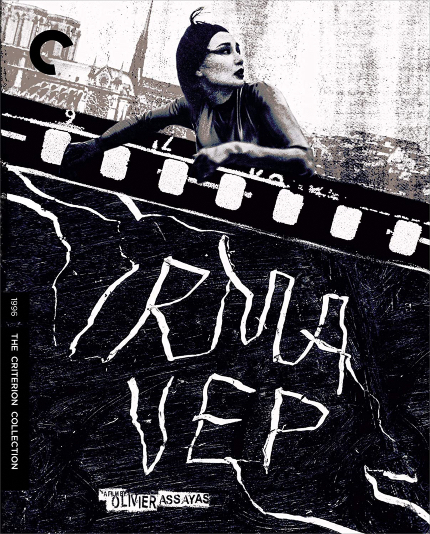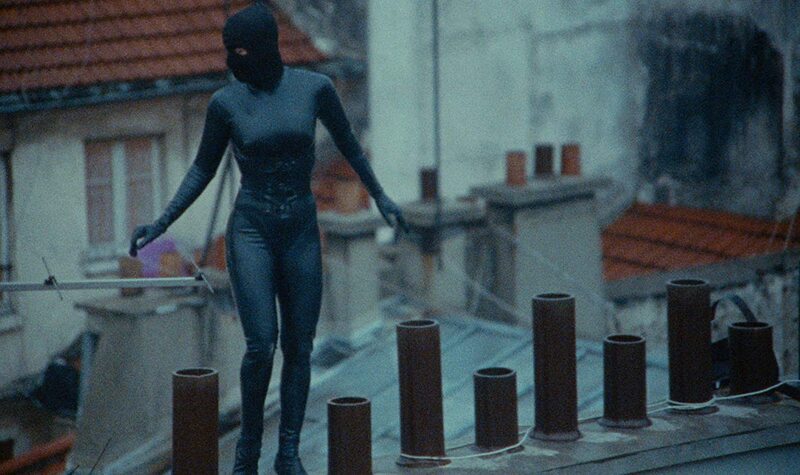Blu-ray Review: Assayas's IRMA VEP Prowls the Criterion Collection
Maggie Chung portrays herself in Olivier Assayas's exploration of filmmaking in the 1990s.

In the still-warm glow of post-Pulp Fiction Tarantino film-buff chic, rising French auteur Olivier Assayas pulled into the moment with the cinematically semi-self-aware Irma Vep.
Experimental and daring, Irma Vep pushes legitimate 1990s lookbacks and rediscoveries into a distorted light. The Tarantino-driven global obsession with Hong Kong action cinema? Assayas’s onscreen filmmaking surrogate mines it for his own film, far outside that genre. Tarantino’s own appropriation of early Nouvelle Vague coolness? Assayas skips a half-century further back to evoke early French silent-moviemaker, Louis Feuillade. Tarantino’s legitimizing of non-linear cinematic storytelling? Assayas serves up a linear puzzle that might as well be scrambled thusly. It’s all enough to thwack the pendulum the other direction, ensuring something like Irma Vep no place in the supposedly newly evolved American mainstream.
Filmstock swapping all through the feature, from color to black and white, 35mm to super 16; varying grades, speeds, and grain? Assayas did it well before Kill Bill (if not before Oliver Stone’s Tarantino-scripted Natural Born Killers). Neil Diamond’s 1967 hit “Girl, You’ll Be a Woman Soon” as covered by Urge Overkill? Assayas will see that with Serge Gainsbourg’s and Brigitte Bardot’s 1968 recording of their ode to 1930s American bank robbers “Bonnie and Clyde,” a song no doubt originally triggered by the French embrace of Arthur Penn’s revisionist 1967 take on the pair as antiheroes. This reoccurring needle drop alone is fuel a-plenty for an essay unto itself.
Not that one-upping the super-cool, super resonant Tarantino-impact was at all the point ... though in a sense, it had to be. That is, Irma Vep is a pop culture commentary on pop culture, specifically, contemporary filmmaking. (Just as a vampire has no reflection in a mirror, the mirror must be inspected when the individual in question is revealed to not be a vampire at all.) The film is cooked up with uncompromising hot-medium tactility; both a celebration of cinema and something of an assessment. As the turn of the new millennium approached, a lot of the 1990s was spent looking backwards. It was a good thing, as today, any sense of history is collectively muted if existent at all.
*****
In a chaotic production office in Paris, a past-his-prime auteur (played in fried fashion by Nouvelle Vague icon Jean-Pierre Léaud) is preparing a remake of a then-80-year-old silent serial. The source material is not without its moments of iconography, but let’s be honest: this isn’t exactly a boiling I.P. Thankfully, this is only 1996, an age when such concerns were not nearly so corporate. If an established filmmaker became fixated on adapting a known property, the odds were refreshingly higher it was their own idea. See the Wachowski’s Speed Racer or Scorsese’s Hugo for a last remnant of such cross-current drive. Though for a reflection on the karma of the film within the film’s production, perhaps Terry Gilliam’s initial doomed attempt at adapting the even older Don Quixote might be more apt.
Maggie Chung, relatively early in her own career, is cast as the lead. Consequently, Chung is playing a version of herself for Assayas, himself an established filmmaker just finding his voice. She is magnificent in the role, bolstered no doubt by Assayas’s admiration of her Hong Kong action work. Irma Vep offers her no such physical challenge, instead nudging her into the realm of the feminine mystique. On one hand, she’s entirely humanized in the film, a fish out of water trying to find her way around the French production. But once she settles into her character’s latex catsuit, purchased during a prolonged sequence in a skeezy sex shop, her extracurricular character explorations take on greater danger, odd riskiness. She’s playing a jewel thief. She infiltrates a luxury hotel on her own time to do just that.
This whole strange project was influenced most heavily by an episode of Les Vampires, a ten-part French silent serial from 1915-16 by Louis Feuillade. That episode, Hypnotic Eyes, is included in its 58-minute entirety on Disc Two of this set. Watching it feels kind of interminable, as it is part six of something- a jewel heist potboiler we have no investment in- and (even by early cinema standards) decompressed to the point of dullness. The Vampires of the title are not supernatural creatures of the night but, in this case, simply a gang of thieves.
It’s only when the actress Musidora as the original Irma Vep, adorned in an eerie mask and skintight leotard, prowls the halls of the central luxury hotel that Hypnotic Eyes momentarily takes on an uncanny quality. These moments, included in Irma Vep itself, may be the whole of Assayas’s inspiration from this early film. Note that when Chung emulates this attempted heist, her unsuspecting victim (annoyed and distracted on the telephone) is a completely naked woman bearing no minor physically resemblance to Musidora herself.
This seems to be a two-Blu-ray set because Criterion ended up with too many odds and ends to fit on a single platter. The resulting package appears tightly curated, then feels scattershot in the moment. Upon further reflection, however, it reveals itself to be rather tightly curated, after all. That said, many of these bonus features aren’t the most easily digestible experiences. There’s an undeniable dryness about most of it, with tangential video artifacts landing alongside of newly-minted singular Zoom diatribes. Still, it’s a rather impressive release for Criterion in the COVID era.
Disc One stays close to Assayas’s movie, which it houses. There’s a brief 2003 retrospective chat with Chung and co-star Nathalie Richard, who played the production costumer who pines for Chung. It’s fine, if fluffy. In the interim, Chung had broken out in a big way in Wong Kar-wai’s transcendent In the Mood for Love. Though at this point it’s only been six or seven years since Irma Vep, she speaks of it as though it were a nice memory from long ago.
On Disc Two, Assayas conjures up an intellectual headwind at his computer as he delivers his nearly-one-hour manifesto on the current state of cinema. It’s a lot to take in, as he transitions from one meaty topic to the next with barely a break, in French (subtitled in English). Even in the final ten minutes, as every phone in the concrete basement he’s recording in begins aggressively ringing, he is not deterred. He simply keeps reading his own words as he leans over to take the receiver, just out of frame, off the cradle and hang it right back up. As for why he doesn’t silence his iPhone that rings multiple times in this stretch, that’s a question for him.
That original Irma Vep actress, Musidora? She of the uncanny quality? There’s a one-hour documentary on her called Musidora, the Tenth Muse, listed alongside Hypnotic Eyes. It turns out that her allure and scantily clad notoriety spread far and wide, netting her jobs in performance arenas in which she had no previous experience, likely because some male producer was enamored with her. (Is this how action star Maggie Chung wound up in Assayas’s French art film?) Musidora is said to be the Bardot of her day, salvaging dull projects and slaying imaginations. The documentary is one of the more satisfying inclusions on this set, even as it does fall within the range of being tangentially at best related to the central topic, Irma Vep.
Here is the full rundown of what this director-approved special edition has to offer:
• New 2K digital restoration, approved by director Olivier Assayas, with 5.1 surround DTS-HD Master Audio soundtrack on the Blu-ray
• New interview with Assayas
• On the Set of Irma Vep, a behind-the-scenes featurette
• Interview from 2003 with Assayas and critic Charles Tesson
• Interview from 2003 with actors Maggie Cheung and Nathalie Richard
• Musidora, the Tenth Muse (2013), a documentary on the actor who originated the role of Irma Vep
• Les vampires: Hypnotic Eyes (1916), the sixth episode in Louis Feuillade’s silent-film serial
• Cinema in the Present Tense, a June 2020 address on the state of cinema by Assayas
• Man Yuk: A Portrait of Maggie Cheung, a 1997 short film by Assayas
• Black-and-white rushes for the film
• English subtitle translation and English subtitles for the deaf and hard of hearing
• PLUS: An essay by critic Aliza Ma
The new cover art by Jillian Adel combines 1990s xerox-zine aesthetic with the beguiling feel of degraded early silent filmstock. It’s perhaps the truest evocation of the soul of Irma Vep, itself an evocation of what might’ve been up and what might’ve been down with cinema of the time. The film, looking and sounding remarkably sonic (replete with a song by Sonic Youth), reverberates these many years later as both uniquely indicative of the past-processing of its time and the uneasy restlessness, the need to burst forward, that ran concurrently.
For Assayas, it is among his first of many outside-the-box deconstructions of a popular medium. In proper 1990s faux self-flagellating style, it’s only appropriate that he begin with his own medium. Irma Vep compellingly rips off while riffing away, in its very own way.








